 Sunday/Weekend
Sunday/Weekend

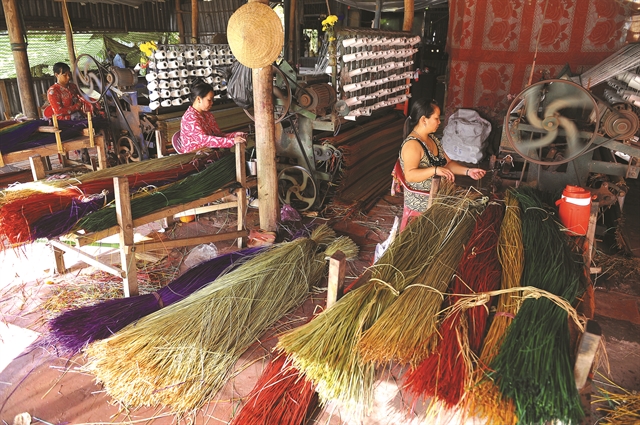 |
| NEW TECHNIQUES: Machines now are used to weave mats in Định Yên Village to increase production. VNA/VNS Photo by Minh Đức |
by Phương Mai
The Mekong Delta province of Đồng Tháp has many craft villages which have existed for over a century. Local authorities and the community have made a lot of efforts to preserve traditional crafts and develop these villages.
“The preservation of craft villages is urgent. It aims to maintain and promote local cultural values and traditional crafts, and boost tourism,” Nguyễn Phước Thiện, deputy chairman of the Đồng Tháp provincial People’s Committee, said.
"The work also encourages household businesses in the villages to expand their business, creates jobs and increases incomes for local people by contributing to rural economic and community development.”
Đồng Tháp currently has 39 craft villages specialising in boat building, mat weaving, flower growing, and food processing.
Of them, sedge mat weaving in Định Yên Commune of Lấp Vò District was recognised by the State as a National Intangible Cultural Heritage in 2013, and so was boat building in Long Hậu Commune of Lai Vung District in 2015.
Located next to the Hậu River, the Định Yên mat village, which emerged in the 1920s, was famous for beautiful handmade mats, as well as its night market, also known as the “ghost” market, because it was held about two hours at night under the light of oil lamps and candles to trade various kinds of mats.
In the past, the market was the place for traders to come and buy mats and then transport them everywhere by boat. But today the market no longer exists.
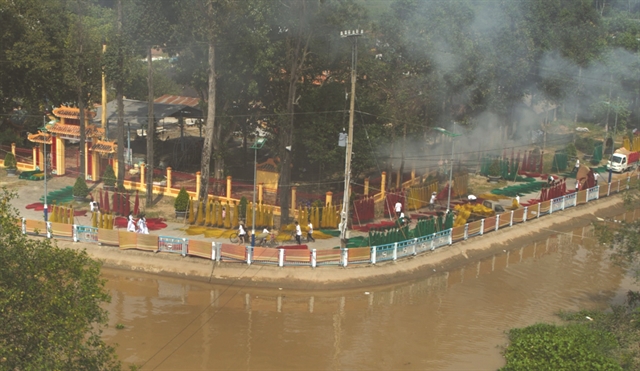 |
| SHOOTING ON LOCATION: Film producer and director Lý Hải restored the Định Yên mat village to use as a filming location for his new movie 'Lật Mặt: Tấm Vé Định Mệnh' (Face-off: The Ticket of Destiny). Photo courtesy of Lý Hải Production |
Film producer-director Lý Hải recently announced to choose the Định Yên mat village as a filming location for his latest movie Lật Mặt: Tấm Vé Định Mệnh (Face-off: The Ticket of Destiny).
“As a native of the Mekong Delta, I want to introduce the beauty and traditional craft of the region to audiences. I immediately think of colourful mats made in Định Yên, so I decided to bring them to my film,” Hải from Tiền Giang Province said.
The filmmaker spent billions of đồng on restoring traditional dyebaths, drying yards, and particularly the night market of the village. He also invited local people to join his movie to make the scenes more lively.
He said that thanks to the support of local authorities and residents, he could make his movie perfect. “I hope my work can contribute to the efforts of local authorities and communities in promoting the Định Yên mat village and its cultural values to the public.”
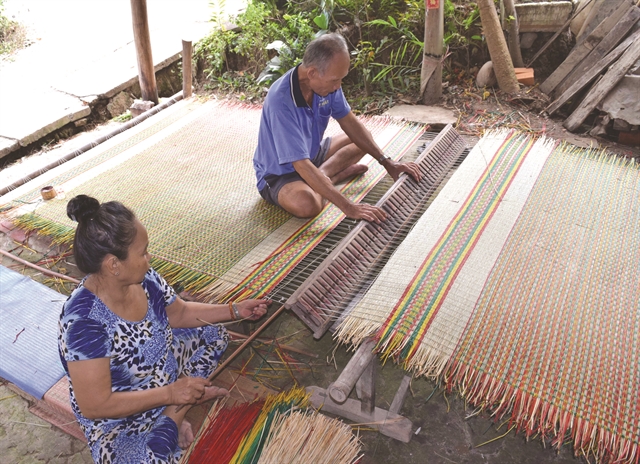 |
| MASTER WEAVERS: Artisans in Định Yên Village still keep the traditional techniques of making mats. VNA/VNS Photo Chương Đài |
Trương Thị Diệp, deputy chairwoman of the Lấp Vò District’s People’s Committee, said: “The district will reopen the night market every month and turn it into a unique and attractive tourist destination of the province. New tours discovering the market and the craft of mat weaving, and new craft products will be introduced to attract more tourists to learn about the traditional crafts of the province.”
She added the province would support artisans to preserve and transfer traditional techniques to younger generations, and at the same time, offer favourable conditions for household businesses to research new products, apply new techniques and expand their business.
“We together can spread the name of the Định Yên mat weaving village further,” she added.
Miniature boat
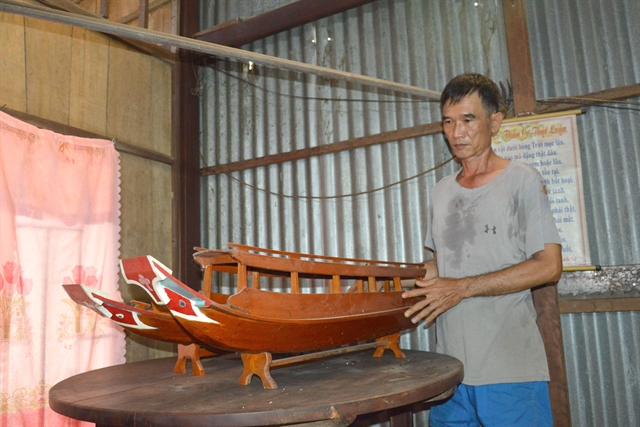 |
| CRAFT BOATS: Artisans from the 100-year-old Long Hậu boat building village make miniature boats as a souvenir to keep the traditional craft alive. VNA/VNS Photo Nhựt An |
To preserve and develop the 100-year-old Long Hậu boat building village, local entrepreneurs made a bold decision to develop new products -- miniature boats as souvenirs.
Boat builder Nguyễn Văn Tốt said customers now preferred composite or metal boats, so the production of wooden boats sharply decreased. Making miniature boats was an effective solution to keep the traditional craft alive and provided him a stable income.
According to the province’s Culture, Sports and Tourism Department, the miniature boats are very welcomed by both local and foreign tourists who love to buy them as souvenirs for family and friends.
Local artisans offer more than 30 models of typical boats in the Mekong Delta such as wooden barge, dinghy, and ghe ngo (Khmer long boat). They are priced at hundred thousands to millions of đồng depending on craftsmanship, size and materials.
The department is working on promoting the village’s new products to domestic and foreign markets, and giving support to artisans who have made a great contribution to the preservation of the boat building craft.
Seeking national recognition
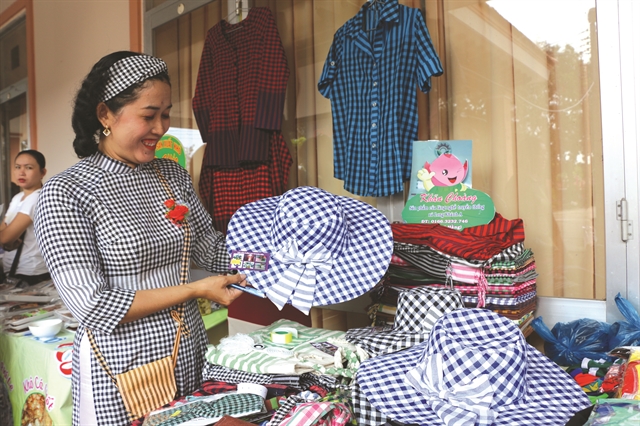 |
| BEAUTIFUL DESIGNS: A tourist is interested in a variety of products of the Long Khánh A scarf weaving village’s signature check cloth. VNA/VNS Photo Chương Đài |
This year, Đồng Tháp targets to seek the State's recognition for its traditional crafts of scarf weaving in Long Khánh A Commune of Hồng Ngự District, and nem chua (fermented pork) in Lai Vung District as a National Intangible Cultural Heritage.
Established more than 100 years ago, Long Khánh A Village used to weave black and white check scarves by hand.
The village was in danger of disappearing in the early 2000s due to the appearance of scarves in different materials and with a variety of designs in the market.
Thanks to local authorities and community’s efforts, weavers in the village have changed their production methods, and use machines to increase productivity and diversify their products.
The village has made check scarves in other colours of blue, red or pink, and improved their design to make them beautiful and fashionable.
The province has worked with Hồng Ngự District and tourism agencies to launch tours introducing the history and development of the village, and create a variety of products to attract tourists, such as handbags, clothes, cravats and hats, or beautiful gift sets from the village’s signature check cloth.
Meanwhile, the fermented pork made in Lai Vung Village has existed for nearly 100 years. Despite challenges, the trade is still growing with more than 20 household businesses producing thousands of rolls per day for domestic market.
In 2013, Lai Vung fermented pork was listed among the top 50 Vietnamese specialties and gifts initiated by the Việt Nam Records Organisation.
Đồng Tháp's culture authority is working with the province’s museum, relevant agencies and communities to prepare dossiers for the two traditional crafts to submit them to the Ministry of Culture, Sports and Tourism to enlist them as a National Intangible Cultural Heritage. VNS




